Welcome to FISH FOOD TIMES
Sep. 2018 issue No.177

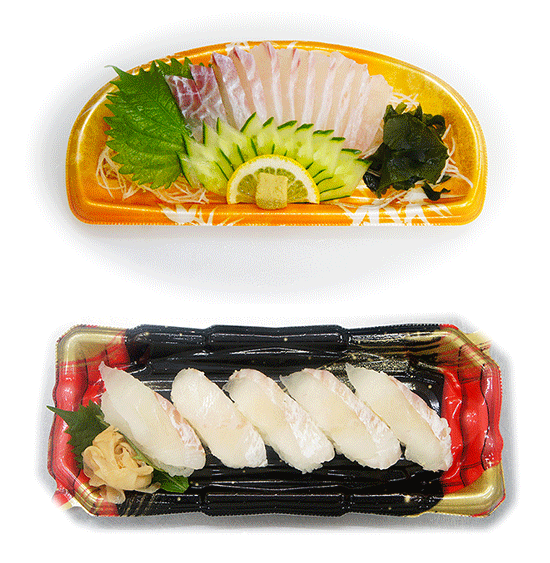
Gray large-eye bream sashimi & sushi
Featured fish with eye
The lower image is Gray large-eye bream. This fish has a pattern like a brown band on the head part. This image does not make it clearer anymore, but the band continues even above and below the pupil, which together with the black of the eyeball seems to penetrate through the eye.
I think that you can understand it because it is exaggerated by enclosing it in a circle in the image of the next lower one. As it seems that a strip of band penetrates through the eyeball like this, it seems that it is named Gray large eyebream (a sea bream with one streak in the eye). But this belt almost disappears when it dies.
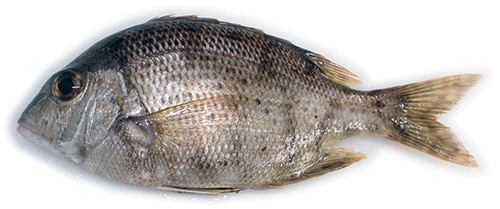
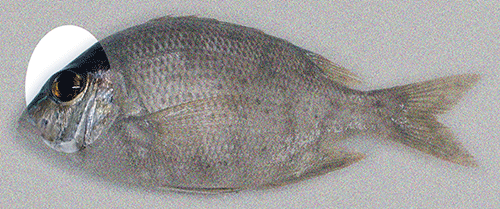
Gray large-eye bream has features in the eyes, so in many regions of the country it often has the letter of 'me'. Tamame in the vicinity of Fukuoka city and in the Kansai region, Meichi in the Tokushima region, Mete in the southern part of Miyazaki Prefecture, others are called with the local name with 'me' attached.
Not only is the eyeball not only characterized, but this exciting big eyes are that when it gets scratched it will give off a kind of peculiar smell like calcium odor, the author has not smelled that smell and is interesting. However, among anglers, even if you catch the Gray large eye bream, if you put it in the cooler box, the inside of the box smells, so some people throw them away, but that is a waste.
Fellow of Grey large-eye bream
Actually, when Grey large-eye bream arrived in the store, we got the same Lethrinidae family, Lethrinus genus, Lethrinus haematopterus (English name / Adjutant), so I shot them side by side like the image below. If you try to arrange fish of the same family Lethrinidae, you can see the difference well.
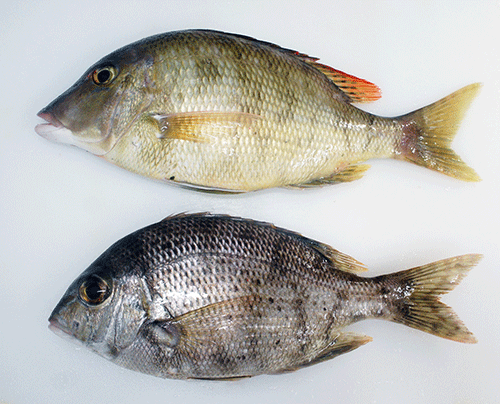
Comparing the side by side images, the group of Lethrinidae family has a so-called sea bream type body shape flattened side to side. Especially Adjutant has a characteristic that snout protrudes forward a lot like Grey large-eye bream, has a strong jaw and teeth, they are to catch benthos such as crustaceans and echinoderms etc. It seems to be in this form.
Well, in this issue we introduced the same fellow's Adjutant as Grey large-eye bream, so let's introduce fellows of the Lethrinidae family who are confusing to distinguish them.
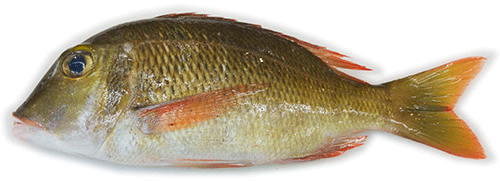
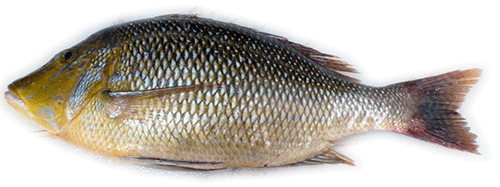
Well, the person who can clearly answer the difference of the fish in the upper image would be a fisherman in Okinawa and the Nansei Islands, or a strong angler on the fish in the South. People in other regions can only explain halfway level what kind of fish it is because what part is different.
In particular, I think that there are some people who say that the image above the two fishs lining up and down is Adjutant, but that is not the case. The name of this fish is "Pacific yellowtail emperor". It is a popular fish of white meat belonging to Lethrinus genus in southern fish, called Kuchinaji in Okinawa, and available at a relatively low price. The eyeball is bigger than Adjutant, the fins' redness is stronger overall, and in particular the red bordering of the tail fin edge is a big point to distinguish from Adjutant. The name of Pacific yellowtail emperor means Adjutant inhabiting beach, it seems that what lives in rocky place of the shore and a shallow sea of coral reef is derived from the name.
And the fish in the lower image is "spangled emperor". It is Lethrinus genus and in Okinawa it is called taman. This fish lives in widespread waters from western Japan to southern Japan including not only Okinawa but also the north of the ocean, has its own name in various places, there are many other names such as tamami, kuchibi, tamame .
Since spangled emperor grows to be the largest of Lethrinus genus, which has the maximum total length of 90 cm, farming is actively carried out in Ishigakijima and Iejima in Okinawa and stable circulation is possible. It can be said that it is the most common and familiar fish among the Lethrinidae family nationwide.
"Futen's tora-san fish" is a seasonal taste limited from late summer to early autumn
Well, the gray large-eye bream, which has many similarly shaped southern group members, belongs to the Lethrinidae family, Gymnocranius genus and lives in shallow waters along the coast of the relatively warm sea. Gymnocranius is not necessarily inhabited only in the southern Japan, it is also caught in the vicinity of the Genkai-Nada in the North Sea and in the Tsushima Strait. However, since the amount to be caught in the first place is very small and the evaluation of the taste is high, when the good freshness arrives in the market, the price seems to be as much as 5,000 yen / kg, This fish does not line up at the sales floor of the store, and it is positioned as an exclusive fish to buy exclusively by Japanese restaurants and high-end sushi restaurants etc.
The alias of grey large-eye bream seems to be also called "Futen's tora-san fish". The reason is "unnoticeably appearing in summer, unnoticeably disappearing in November of autumn." By the time the old bon festival is over, there are many sudden arrivals to the fish market, especially in August to September. After that it began to gradually decline and it is "seasonal taste limited from late summer to early autumn" which is almost unavailable from around November until the summer of the following year.
When it is disassembled into three pieces, an image under the white body which appears to be clear can clearly appear, and it can be determined that the chiai meat of fish near the small bone is also very few.
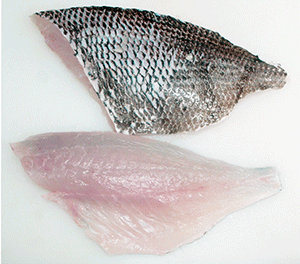
And if you remove the skin, you can see the red color pattern which is very plain from the bottom of the leather.
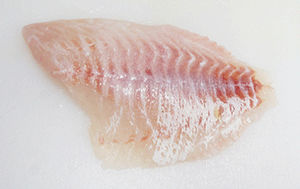
The gray large-eye bream is a very elegant and transparent sense of white meat, compared to the red shade of the red pattern after removing the skin of the same white meat spotted knifejaw in the image below. Compare both images and you will understand the difference well.
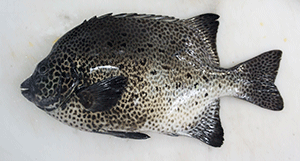
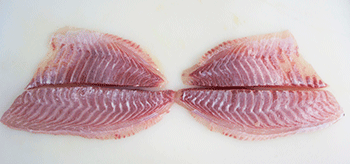
Attractive to assortment rich fresh fish
Well, I tried to commercialize grey large-eye bream which disassembled into three pieces and removed the skin.
The price of grey large-eye bream purchased at this time was not high, 5,000 yen / kg, it was about 1,000 yen / kg. I calculate that the cost is about 250 yen in half and I remember that the set selling price was about 500 yen. If a person who knows the value of this fish saw this price it became what might not believe me as grey large-eye bream.
To increase the value of grey large-eye bream, I thought that it would be better to finish the product in separate body with back body and belly body. First of all, for belly body, because abdomen is not thick and difficult to produce volume sense, I cut it thinly and spread it into sushi so that it made it easier to make the product value.
On the other hand, since the back body is thicker and heavier than the belly body, I decided to give a sense of value by making it hiratsukuri sashimi.
The following image is an example of commercialization made to enhance the value by making full use of the characteristics of back body and belly body.
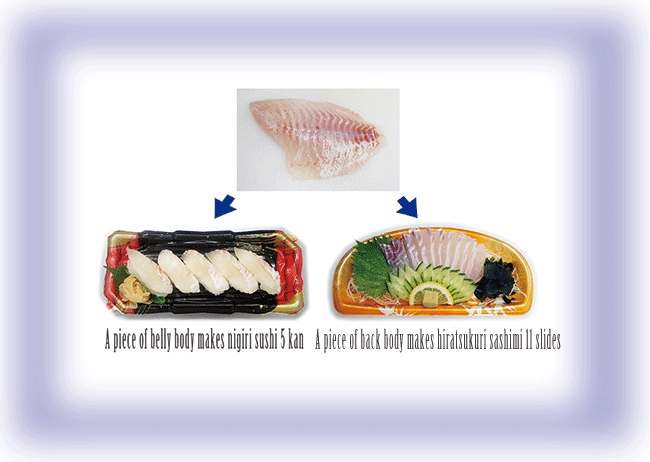
In the fish shop where I am instructed, there are several shops where such worthy fish are not particularly high selling price, but ordinary people can also buy at regular price. Such shops are not located in large cities, it is definitely more local shops, it may be said that it is possible to do because it is rural. Even if it is true, means of delivery and collection by net are emerging, even in urban stores, if it comes to this age. Using these methods, it is possible to gather various types of fish from all over the country.
But at this time, I feel that there are few stores that are fascinated by the expectation that they might be able to meet some rare fish such as grey large-eye bream.
Regardless of where you go to fish shops, similar fish are sold at similar prices, but, for example, a person who can understand a fish like the writer is "It's pretty good at it ..." as I say, such a fish shop that is interesting is getting less and less and it is truly lonely.
I think that it is common not only to the fish store but also to any sales floor, but there are obvious differences between shops that are prosperous as well as shops that are not so, depending on whether there is "the fascination of assortment" , I think it is a big difference. Speaking of the fish shop, the fascination of assortmen of raw fish has a big presence, and aside from whether customers buy or not buy, if the assortmen of raw fish is abundant, evaluate the store highly, if it is poor It does not evaluate.
If the variety of raw fish is abundant, it has the ripple effect of spreading raw fish to fillets, sashimi, sushi, which results in a clear difference from the fish shops with poor selection of raw fish and that will lead to the charm of the whole fish shop as it is.
The current supermarket shop has forcibly promoted efficiency, rationalization, labor saving, centering, etc. in an effort to create a mechanism that anyone can do part-level talent with low labor cost. As a result, there are actual situation that veteran engineers who are good at fish technology and knowledge have decreased. It seems that such reality is also becoming a factor that can not be attracted to the attractiveness of raw fish selections at the fish shop because the details of the fish and the skilled fishery persons with good arms have decreased.
As a wish of the author, I would like you to be a store where "Futen's Tora-san fish" is stocked several times during the year and a few months around September. I would like customers to be expected to "be gray large-eye bream might be displayed if you go to that shop."
Does your shop have a posture like the following words? It is the word "I make the thing which seems to sell the price that seems to sell and sell only popular quantity". When such defense becomes visible, it will gradually fall down the slope little by little in an invisible form unintentionally.
Now it is time to focus on raw fish, but in September it is not a story of the level of "Let's sell raw saury this year." According to recent information, this year 's saury fishery seems to be out of extreme fishing that lasted for years, so fisheries officers may be Enthusiastic, selling this year only.
But as I have written so far, the author wants to say that in September everyone like that would not be looking at the same thing as thinking about the same thing. Like "grey large-eye bream" picked up in this issue, "a stance to make an effort to sell season but minor fish" is an important thing to the current fisherman. That is the differentiation of fish shops.
An opinion and the communication are to iinfo@fish food times
Date of updating 1 Sep. 2018
